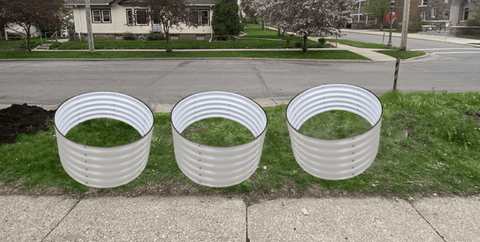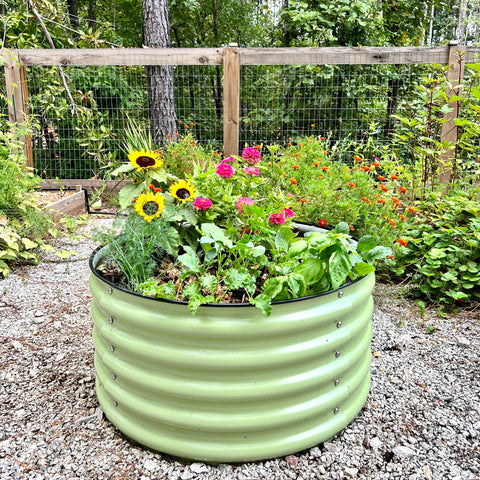5 Materials Placed At the Bottom of The Raised Garden Beds
The raised garden beds can help you grow a large number of organic fruits and vegetables in your home garden without any effort. Of course, you can always build one yourself, and their service life is long enough to be worth the investment. Whether you are planting cucumbers and other vegetables or herbs and flowers, garden beds may be the right choice.
The raised garden bed can be made of various materials, but there are certain standards for what is arranged or filled. Here, you will find the five best materials to put at the bottom of the raised garden bed, and what you should use according to what you plant.

What is a raised garden bed?
The raised garden bed is an elevated part of your yard, where you can freely garden. The structure is located at the top of the ground and is about 2 to 3 feet high. It can be made of a variety of materials, including wood, metal or stone
You can use the raised garden bed to grow many things, including vegetables, herbs, flowers, etc. The raised garden bed allows you to grow food in small areas without too much soil or space. Even better, if you have a bad back, this is a must for gardening.
Material placed at the bottom of the garden bed
Finding the right material for the bottom of a raised garden bed can be daunting.
You don't want to make the wrong choice, otherwise, you will let them rot or decompose prematurely before planting the garden! Here are some of the best materials to put at the bottom of your garden bed. Whether it's from scratch or an existing bed that needs to be upgraded.
1) Cardboard
If your budget is limited, cardboard should be at the top of the list. Cardboard is cheap and easy to buy, maybe just lying around your house.
They provide excellent drainage, so your plants won't rot. You can arrange cardboard at the bottom of the elevated bed, cover it with soil, and then you can go. And because it is made of recycled materials, you will feel good about your decision.
However, cardboard decomposes quickly and will not last as long as other materials. You can use cardboard containing layers, which will buy you some extra time.
When selecting a material, make sure it has no smooth surface or coating. When shiny cardboard decomposes, it will produce toxic chemicals that will damage your plants.
2) Newspapers
If you cannot use a covering or landscape fabric, consider placing the newspaper at the bottom of the raised garden bed. Newspapers are cheap and can help keep water in the soil below.
One big advantage: By layering newspapers, you can prevent nematodes from destroying your soil.
Newspapers are thin, so they decompose quickly. Make sure they are well layered so you don't have to replace them often. The thickness of the newspaper layer should be about 1/2 inch, although the thicker the layer, the better.
Once decomposed, newspapers release carbon into the soil. Microbes feed on carbon, making the soil healthier and more nutritious.

3) Covering
The best time to apply mulch is when you plant new plants, want to increase some winter protection, or need to improve the soil. However, you can also add it to the bottom of the elevated garden bed.
For example, if your garden bed has been empty for some time, consider adding organic or inorganic mulch to the bottom. Just cover it with soil to see your plants grow well.
Organic mulch is made of compost and chopped parts of plants, which can add nutrients to the soil while decomposing. If you cannot obtain organic mulch, you can purchase inorganic mulch at any gardening store. Or, create your own!
If you have more than one garden bed, the path between them should be wide enough to accommodate a unicycle. In this way, you can easily transport the required materials to your work site.
No matter what kind of mulch you use, it will prevent weeds from growing and lock water in the soil.
4) Landscape fabric
Lined garden beds will last longer and prevent hazardous chemicals from contaminating the soil. If you are looking for cheap weed barriers for your garden bed, try using landscape fabrics. The manufacturer uses woven polypropylene to make landscape fabrics that allow air and water to pass through while preventing weeds from taking root and sprouting.
It is also easier to cut landscape fabrics than cardboard, and can be used as a weed barrier under mulch or on topsoil. Although, there are disadvantages to using this material - it is expensive and will prevent beneficial insects. But considering the durability of the materials, if you hate the work in the yard, it will be worth your investment.
Professional tips: If you have a garden bed made of creosote railway sleepers or arsenic treated wood, it is better to completely remove the wood from the yard. This will prevent toxins from continuing to migrate into your soil.
5) Plastic
Plastic is another cheap material for garden beds. If you have an old pool cover or plastic tarpaulin, these will work well. If not, please don't worry - the polypropylene garden bed lining in your local store can solve the problem well.
Before placing the plastic cloth under the elevated bed, cut the drain hole on the plastic cloth. This will allow the water to drain properly and prevent future problems.
Protecting your vegetation with a plastic lining will create a non-toxic barrier on your garden bed. Wood can carry toxins unconsciously, so it is best to be careful and lay plastic barriers.
Professional tips: Avoid using plastic as the base of the dig free bed; It will restrict air and water from reaching the soil below. In addition, plastic can cause waterlogging in beds and other drainage problems, so be sure to pay attention to your plants.

The best location for garden beds
You can use raised garden beds in a variety of environments, from traditional garden beds to city balconies. The best location for a raised garden bed is where you can easily reach, and there is plenty of sunlight and water, because most plants need 6 to 8 hours of sunlight.
When selecting a location, avoid windy areas and frost pockets. When considering soil, avoid any marshy areas because you need water to drain well.
Upgrade in gardening
If you don't use a raised garden bed, it's definitely time to start! Of course, they make gardening easier and are ideal for small spaces. If you have children, they will like to dirty their hands and help in the garden.
